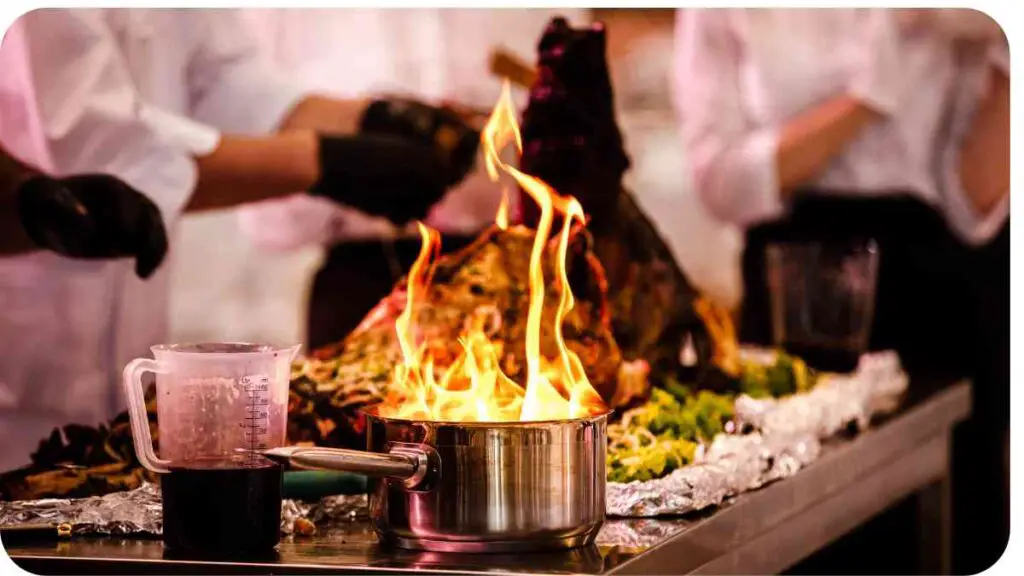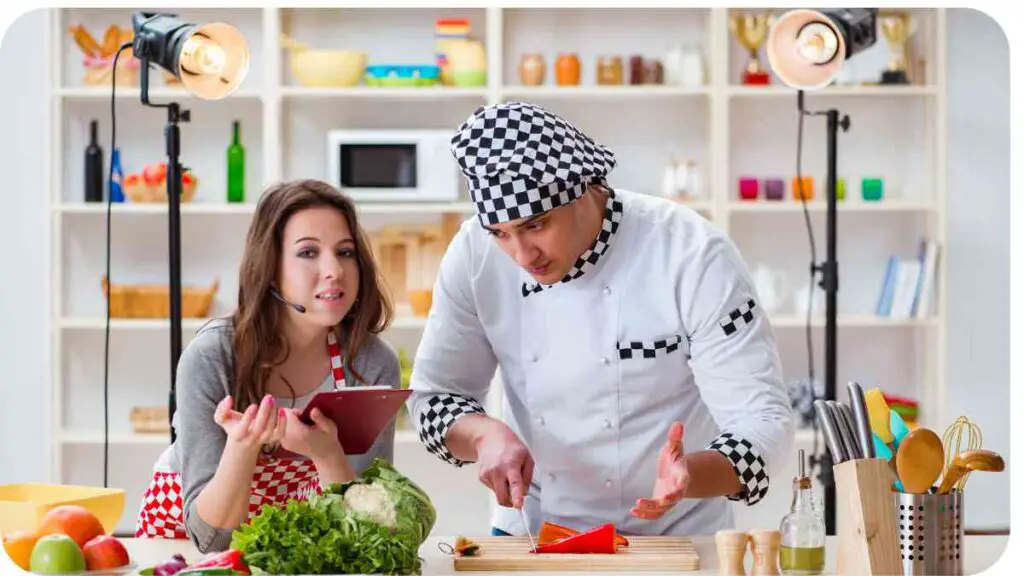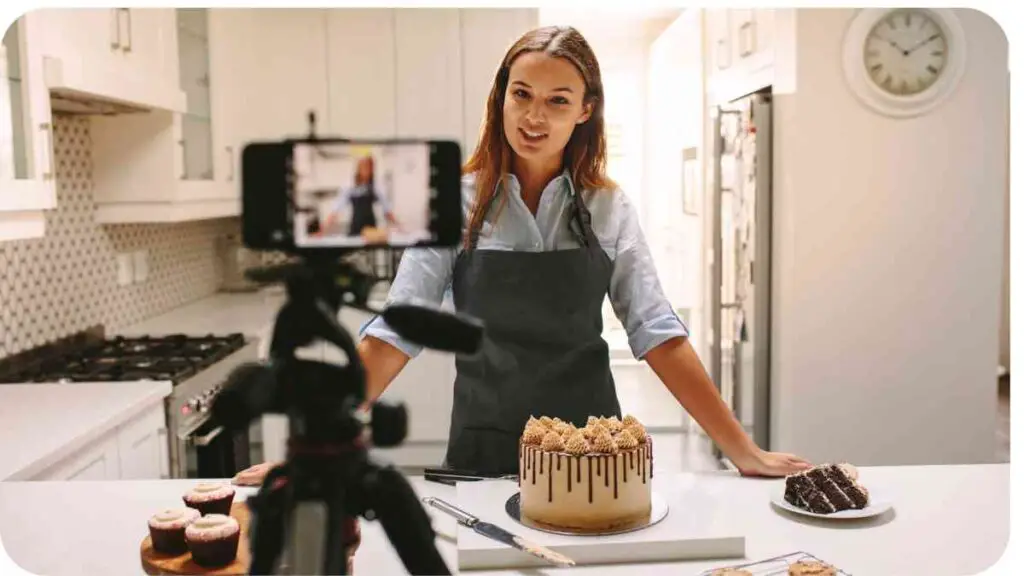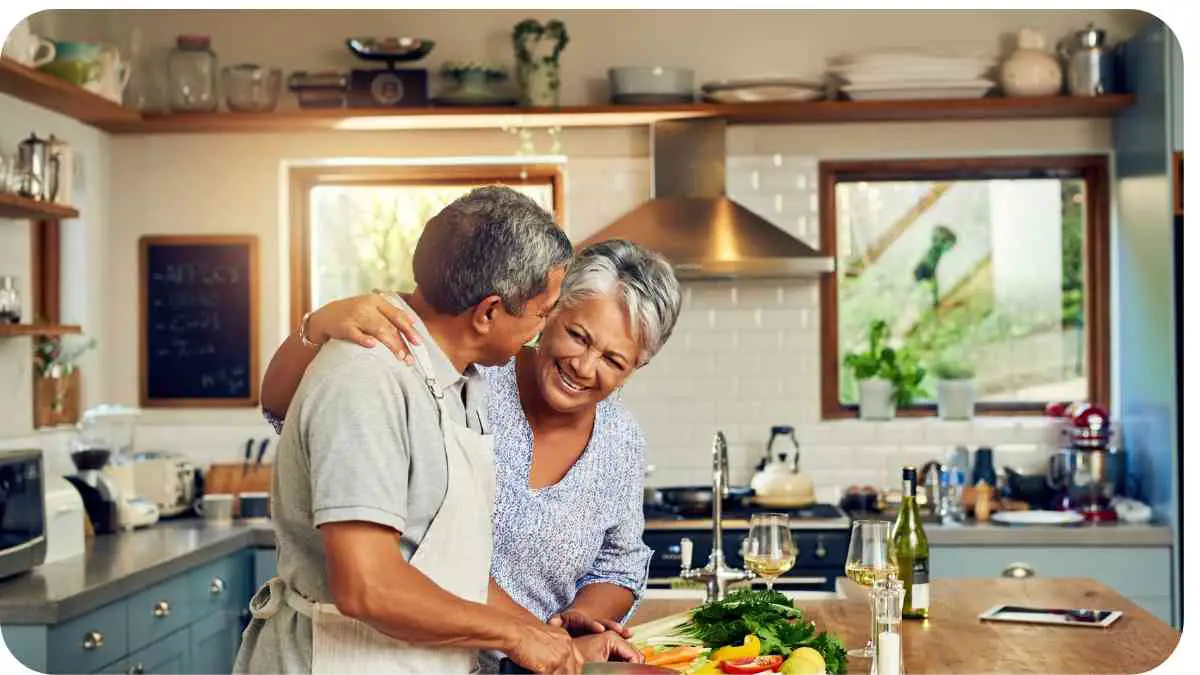Cooking shows have become a staple in modern entertainment, captivating audiences with tantalizing dishes prepared seemingly effortlessly. However, the allure of these shows often creates unrealistic expectations for home cooks.
In this article, we’ll delve into the stark differences between the speed showcased on cooking shows and the more practical pace of home cooking.
| Takeaways |
|---|
| 1. Set Realistic Expectations: Acknowledge the differences between cooking shows and home cooking to enjoy the process. |
| 2. Time Management: Understand the time disparities and adjust your expectations for a more relaxed home cooking experience. |
| 3. Equipment Adaptation: Embrace the limitations of your home kitchen, and focus on making the most of the tools you have. |
| 4. Balancing Precision and Creativity: Find a balance between following recipes precisely and infusing your personal creativity into dishes. |
| 5. Learn from Mishaps: Turn cooking mishaps into learning opportunities, and develop the skill of improvisation. |
| 6. Regular Practice: Improve your skills through consistent practice, emphasizing knife skills, flavor pairing, and time management. |
| 7. Professional Insights: Gain inspiration from professional chefs, adopting their organizational methods and problem-solving approaches. |
| 8. Striking a Balance: Find the equilibrium between cooking efficiently and maintaining the quality of your home-cooked meals. |
| 9. Continuous Learning: Explore further resources, including cooking shows on Netflix and insightful articles, to continue enhancing your culinary knowledge. |
| 10. Enjoy the Journey: Above all, savor the joy of cooking and the satisfaction that comes from creating delicious meals at home. |
2. The Allure of Cooking Shows

Cooking shows, with their dazzling set designs and expertly crafted dishes, can make anyone believe that preparing a gourmet meal is a breeze. Let’s break down the key disparities between the mesmerizing world of cooking shows and the down-to-earth reality of home cooking.
Enhance your culinary skills with these essential kitchen tools, ensuring every dish reaches its full potential. From precision cutting to efficient cooking, these tools are a game-changer for home chefs.
Table: Key Differences Between Cooking Shows and Home Cooking
| Aspect | Cooking Shows | Home Cooking |
|---|---|---|
| Pacing | Rapid and Dynamic | Steady and Practical |
| Presentation | Flawless and Artistic | Homely and Imperfect |
| Equipment | Professional Grade | Standard Kitchen Tools |
| Time Management | Edited for TV | Real-Time Experience |
3. Setting Realistic Expectations
While cooking shows provide inspiration, setting realistic expectations is crucial for a positive home cooking experience. Let’s explore common misconceptions and the reality of cooking in a home kitchen.
Table: Common Misconceptions vs. Home Cooking Realities
| Misconception | Home Cooking Reality |
|---|---|
| Effortless Perfection | Learning Curve and Practice Required |
| Quick and Easy Recipes | Varied Difficulty Levels of Recipes |
| Picture-Perfect Results | Embracing Imperfections |
| Instant Mastery | Continuous Learning Process |
4. Time Management in Cooking Shows

One of the most noticeable differences between cooking shows and home reality is the perceived speed of cooking. Let’s compare the timeframes presented in cooking shows to the more practical timeframes for home cooking.
Streamline your cooking routine with the comprehensive insights in this ultimate guide to meal planning. Discover practical tips and strategies to simplify your home cooking, making it efficient, enjoyable, and stress-free.
Table: Time Comparison – Cooking Show vs. Home Cooking
| Time Activity | Cooking Shows Duration | Home Cooking Duration |
|---|---|---|
| Ingredient Prep | 10 minutes | 20 minutes |
| Cooking Process | 30 minutes | 60 minutes |
| Plating and Presentation | 15 minutes | 30 minutes |
| Total Time | 55 minutes | 110 minutes |
5. Professional Kitchen vs. Home Kitchen
The equipment available in professional kitchens on cooking shows can be vastly different from what home cooks have access to. Let’s explore the disparities in kitchen equipment.
Table: Equipment Disparities – Show Kitchen vs. Home Kitchen
| Equipment | Cooking Show Kitchen | Home Kitchen |
|---|---|---|
| High-End Appliances | Industrial-Grade Stovetops and Ovens | Standard Residential Appliances |
| Specialized Utensils | Professional-Grade Knives and Pans | Common Household Utensils |
| Plating Tools | Artistic Plating Accessories | Everyday Plates and Utensils |
| Expansive Workspaces | Multiple Workstations | Limited Counter Space |
6. Ingredients Availability and Preparation
The variety and availability of ingredients can significantly impact the cooking experience. Let’s discuss the challenges home cooks face when it comes to ingredient sourcing and preparation.
Table: Ingredient Challenges in Home Cooking
| Challenge | Home Cooking Reality |
|---|---|
| Limited Ingredient Selection | Adapting Recipes Based on Available Ingredients |
| Freshness and Seasonality | Seasonal Constraints and Quality Considerations |
| Prepping Time | Additional Time Required for Washing, Chopping, and More |
| Storage Limitations | Making the Most of Limited Storage Space |
7. Precision and Creativity
Balancing precision and creativity is a key aspect of cooking. Let’s explore how cooking shows emphasize precision while home cooking allows for a blend of creativity and practicality.
Take your meal prep to the next level using these innovative kitchen tools. From time-saving gadgets to efficient utensils, revolutionize the way you prepare meals, making the process more enjoyable and efficient.
Table: Balancing Precision and Creativity in Cooking
| Aspect | Cooking Shows | Home Cooking |
|---|---|---|
| Strict Measurements | Emphasis on Precise Quantities | Flexibility with Measurements |
| Artistic Presentation | Creative Plating Techniques | Focus on Tasty and Wholesome Meals |
| Adapting Recipes | Rarely Deviate from Original | Experimenting with Flavors |
| Personal Touch | Professional Touches and Techniques | Homey and Personal Style |
8. Dealing with Mishaps
Mistakes happen in every kitchen, but how they are handled differs between cooking shows and the reality of home cooking. Let’s discuss how to navigate cooking mishaps at home.
Table: Handling Cooking Mishaps – Show vs. Reality
| Mishap | Cooking Show Approach | Home Cooking Approach |
|---|---|---|
| On-Air Mishaps | Editing and Retakes | Improvisation and Adaptability |
| Ingredient Shortages | Behind-the-Scenes Assistance | Creative Substitutions |
| Burnt or Overcooked Food | Replacement with Perfectly Cooked | Salvaging and Flavor Adjustments |
| Presentation Issues | Professional Plating Corrections | Rustic Presentation with Charm |
9. The Importance of Practice
Regardless of the disparities, practice plays a crucial role in improving one’s cooking skills. Let’s explore the benefits of regular cooking practice at home.
Table: Benefits of Regular Cooking Practice
| Practice Aspect | Improvement Result |
|---|---|
| Knife Skills | Efficient and Safe Cutting Techniques |
| Flavor Pairing | Enhanced Palate and Creative Combinations |
| Time Management | Streamlined Cooking Process |
| Recipe Adaptation | Confidence in Modifying Recipes |
10. Expert Tips for Home Cooks

Drawing insights from professional chefs and experienced home cooks, let’s provide some actionable tips to enhance the home cooking experience.
Delve into the comparison of home cooking versus restaurant dining to make informed choices about your meals. Explore the health aspects of both options and discover the benefits of preparing your meals at home for a healthier lifestyle.
Table: Quick Tips for Improving Home Cooking Skills
| Expert Tip | Impact on Home Cooking |
|---|---|
| Prep Ahead of Time | Streamlines Cooking Process and Reduces Stress |
| Taste as You Go | Adjusts Seasoning and Ensures Balanced Flavors |
| Master Basic Knife Skills | Enhances Efficiency and Safety in the Kitchen |
| Understand Your Ingredients | Improves Adaptability and Substitution Skills |
| Embrace Imperfections | Focus on the Joy of Cooking, Not Perfection |
11. Behind the Scenes Reality
Behind the glamorous façade of cooking shows lies a world of meticulous planning and teamwork. Let’s uncover some secrets of what happens behind the scenes.
Table: Behind the Scenes – Secrets of Cooking Shows
| Behind the Scenes Aspect | Unveiling the Reality |
|---|---|
| Pre-Prepped Ingredients | Ready-to-Use Ingredients for Efficiency |
| Multiple Takes and Retakes | Achieving Perfection Through Iteration |
| Sous Chefs and Support Staff | Collaborative Effort Behind Each Episode |
| Extensive Recipe Testing | Ensuring Foolproof Results for Home Cooks |
12. Balancing Speed and Quality
While cooking shows emphasize speed, home cooks often prioritize quality. Let’s explore how to strike a balance between these two crucial aspects in the kitchen.
Table: Achieving Balance – Speed vs. Quality
| Aspect | Balancing Act in Home Cooking |
|---|---|
| Efficient Prep Work | Reducing Time Without Compromising Quality |
| One-Pot and Sheet Pan Recipes | Minimizing Cleanup Efforts While Maintaining Flavor |
| Batch Cooking | Planning Ahead for Quick and Nutritious Meals |
| Prioritizing Key Techniques | Focusing on High-Impact Cooking Skills for Efficiency |
13. Learning from the Pros
Gaining insights from professional chefs can significantly elevate your home cooking skills. Let’s delve into the lessons we can learn from culinary experts.
Table: Lessons from Professional Chefs
| Chef’s Wisdom | Application in Home Cooking |
|---|---|
| Mise en Place | Organized and Efficient Cooking Setup |
| Flavor Layering | Building Complexity and Depth in Home Dishes |
| Presentation Techniques | Elevating the Visual Appeal of Homemade Meals |
| Culinary Problem-Solving | Navigating Challenges with Creativity and Resourcefulness |
14. Conclusion
In conclusion, while cooking shows offer inspiration, it’s crucial to acknowledge the differences between the captivating speed of the screen and the practical reality of home cooking. Embrace the joy of the process, learn from mishaps, and continuously practice to hone your skills. By understanding the nuances, you can create delightful meals that reflect your personal style and taste.
Further Reading
- Best Cooking Shows on Netflix: Explore a curated list of the best cooking shows available on Netflix, from culinary competitions to inspiring documentaries.
- Cooking 101: Heat Levels and Cooking Speed: Delve into the fundamentals of cooking, understanding heat levels, and mastering the art of cooking speed with insights from Balanced Kitchen.
- Secret Chef: Cooking Show Review on Hulu: Read a review of the intriguing cooking show “Secret Chef” on Hulu, featuring David Chang, and discover whether it lives up to the hype.
FAQs
What are the key differences between cooking shows and home cooking?
Cooking shows often showcase rapid and dynamic pacing, flawless presentation, and professional-grade equipment, while home cooking is characterized by a steadier pace, homely presentation, and the use of standard kitchen tools.
How can I balance precision and creativity in my cooking?
While cooking shows emphasize strict measurements and artistic presentation, home cooking allows for flexibility in measurements, experimenting with flavors, and adding a personal touch to dishes.
What are some common misconceptions about home cooking?
Common misconceptions include the belief that home cooking is effortlessly perfect, recipes are always quick and easy, and results should be picture-perfect. In reality, there is a learning curve, recipes vary in difficulty, and imperfections are embraced.
How can I handle cooking mishaps at home?
Unlike cooking shows with behind-the-scenes editing, home cooks should embrace improvisation and adaptability. Creative substitutions, salvaging overcooked food, and presenting dishes with rustic charm are part of the home cooking experience.
What expert tips can help me improve my home cooking skills?
Experts recommend prepping ahead of time to streamline the cooking process, tasting as you go to adjust seasoning, mastering basic knife skills for efficiency, understanding your ingredients for adaptability, and embracing imperfections for the joy of cooking.

Hi, I’m Hellen James! I’m a professional chef who has been cooking for over 12 years. In my career, I’ve worked at some of the world’s most prestigious hotels and restaurants. My expertise lies in creating recipes that are simple but delicious, and I love to experiment with new ingredients and techniques. I started this blog because I want to share my passion for cooking with everyone who loves food as much as I do.


